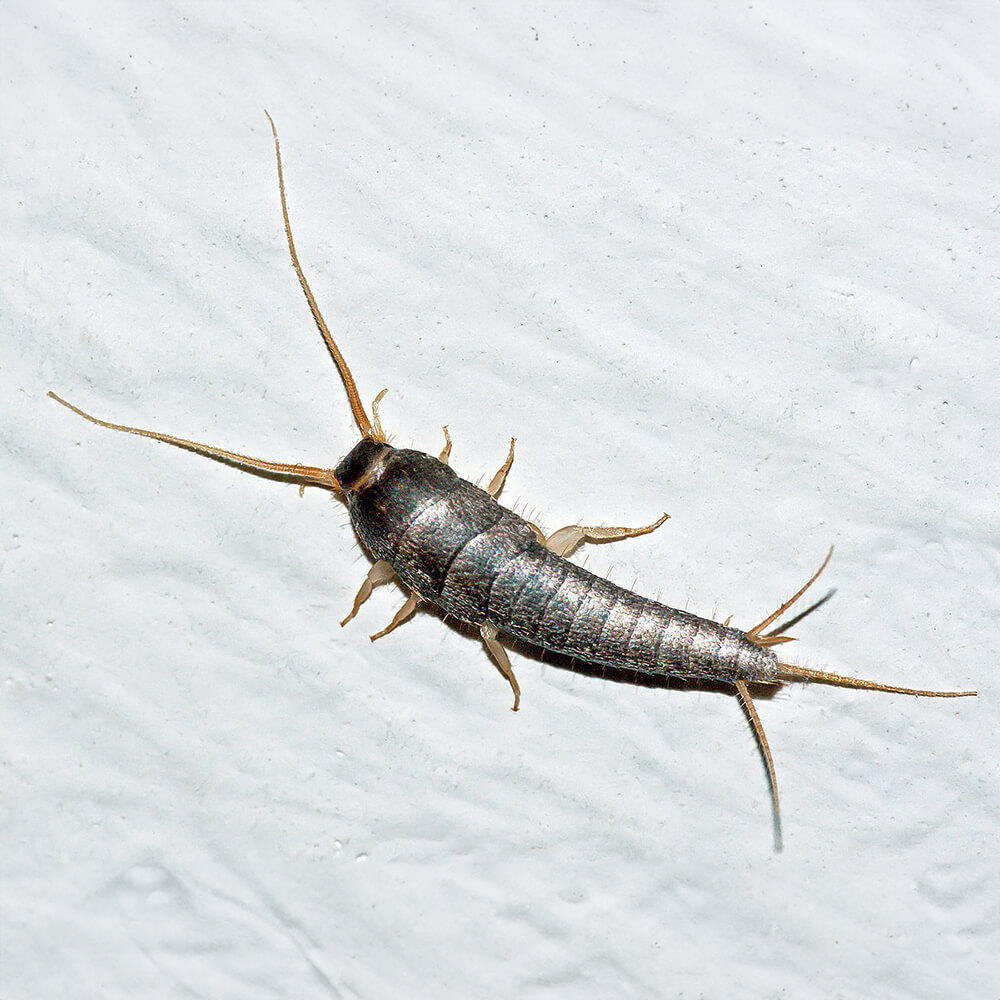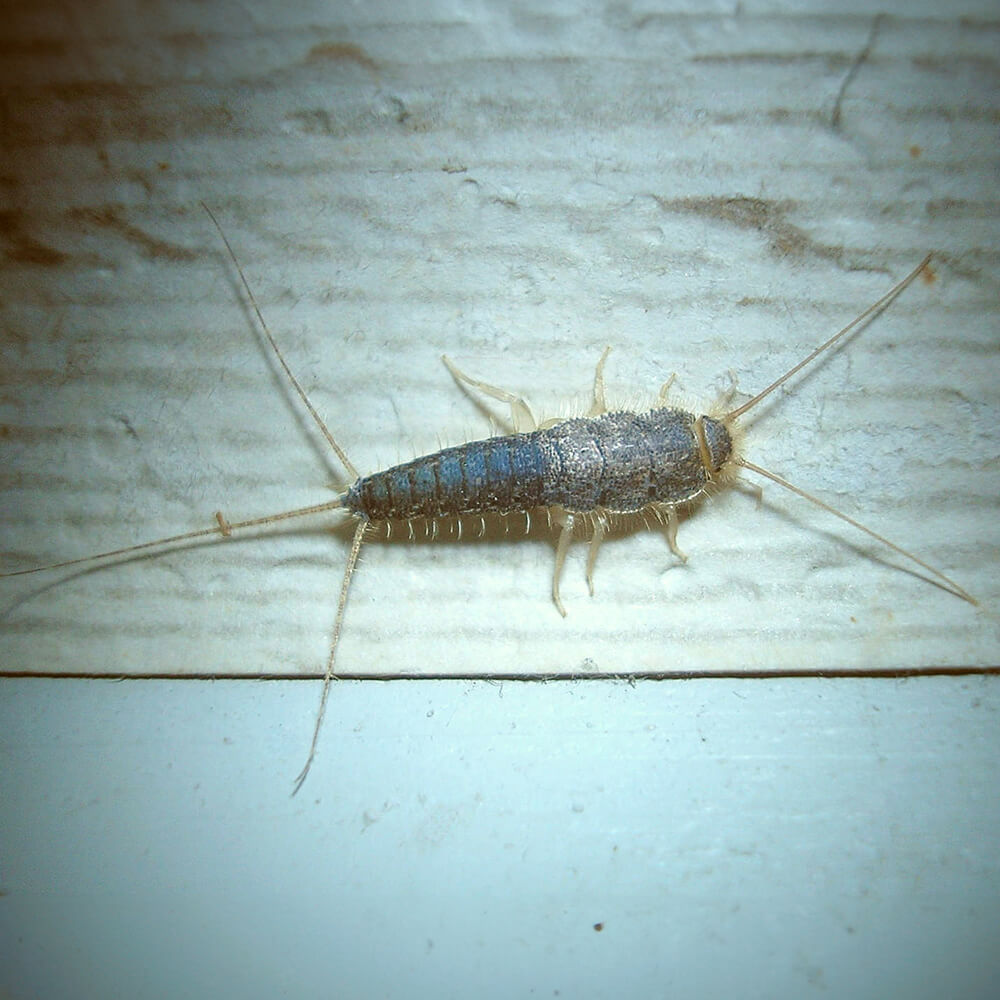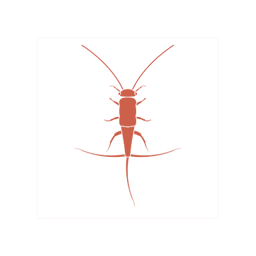Silverfish Control Guide – Eliminate Pests Fast
Silverfish are small, silvery-gray insects that are often found in damp and dark spaces. They are a common household pest known for their preference for starchy and sugary foods, as well as paper and fabric. Silverfish infestations can be a nuisance, as they can damage books, clothing, and other valuable items. To keep them at bay, it’s important to maintain a dry and well-ventilated environment, as silverfish thrive in high humidity. If you suspect a silverfish problem, consider seeking professional pest control or using DIY methods to effectively address the issue and protect your belongings.
The different species of silverfish
The two most common species of silverfish are:

Lepisma saccharina
Commonly known as the “common silverfish,” this species is widespread and frequently found in homes and businesses. They are known for their silvery appearance and distinctive, carrot-shaped bodies.

Ctenolepisma longicaudata
Also referred to as the “gray silverfish,” this species is another common type of silverfish. They are similar in appearance to the common silverfish but may have slight variations in color.
These two species are the ones most commonly encountered by people in various parts of the world. While there are other species of silverfish, they are not as prevalent or well-known as these two.
Silverfish are easily recognizable by their teardrop-shaped bodies and silvery scales, which give them their name.
The life cycle of silverfish
The life cycle of silverfish is a fascinating and important aspect of understanding these household pests. Silverfish undergo gradual metamorphosis, which consists of three stages: egg, nymph, and adult.

Egg Stage
It all begins with the female silverfish laying small, oval-shaped eggs in hidden, sheltered spots. These eggs are often deposited in cracks, crevices, or other dark, undisturbed areas where they are less likely to be noticed.

Nymph Stage
Once the eggs hatch, they release nymphs that resemble miniature adult silverfish but are smaller and lighter in color. Nymphs continue to molt, shedding their exoskeleton several times as they grow. These molts are essential for their development, and it’s during this stage that they acquire their silver appearance. Nymphs are agile and move quickly, foraging for food and moisture.

Adult Stage
After numerous molts, nymphs eventually reach adulthood. Adult silverfish typically measure around 0.5 to 1 inch in length and are recognizable by their silver, teardrop-shaped bodies and distinctive, bristle-like appendages at the rear. They are also known for their rapid, fish-like movements, hence the name “silverfish.”
Understanding the life cycle of silverfish is crucial for effective pest control. Their preference for dark, damp environments and their diet of starchy and sugary materials make them unwelcome guests in homes and businesses. Implementing measures to reduce humidity, seal entry points, and eliminate food sources can help prevent and control silverfish infestations. If you encounter a persistent problem, consider seeking professional pest control services to manage and eradicate these pests effectively.
Female silverfish can lay up to 100 eggs at a time, contributing to rapid infestation growth.
The seasons most conducive to silverfish
Silverfish are curious little creatures known for their silvery appearance and their preference for dark, damp environments. While they can be found year-round, there are certain seasons when they are most active and tend to thrive.

Spring
Spring is a time when silverfish tend to become more active. The rising temperatures and increased humidity levels make this season favorable for their activities. Silverfish are drawn to moisture and humidity, and spring offers the ideal conditions for them to reproduce and seek out sources of food. To prevent infestations during spring, it’s crucial to maintain a dry and well-ventilated home.

Autumn
As the temperatures drop and outdoor conditions become less favorable, silverfish often seek refuge indoors. Autumn sees an increase in silverfish sightings as they look for warmth and shelter. Regular inspections for potential entry points, as well as proper sealing of windows and doors, can help prevent these pests from taking up residence in your home.
Summer
Summer is another season when silverfish are in their element. The warmth and higher humidity levels create a comfortable environment for these pests. This is when silverfish populations tend to grow rapidly. To keep them at bay during summer, it’s essential to ensure your living spaces are cool and dry. Sealing any cracks and gaps in your home can also deter silverfish from invading.
Winter
Winter is a season when silverfish activity tends to slow down. Being cold-blooded insects, they are less active in colder temperatures. However, they don’t disappear entirely. You may still encounter them in heated areas of your home, such as bathrooms and kitchens. Maintaining a clean and dry environment is essential to discourage their presence, even during the winter months.
Understanding the seasons when silverfish are most active is vital for effective prevention and control. By keeping your living spaces dry, well-ventilated, and sealed, you can significantly reduce the risk of silverfish infestations year-round. If you suspect a silverfish issue, consider consulting with a pest control professional to address it effectively and protect your property from damage. Staying proactive in safeguarding your home from these resilient pests is essential, regardless of the season.
These insects are primarily nocturnal, meaning they are most active during the night, making them elusive and hard to spot.
Where do silverfish come from, their habitat
Silverfish, scientifically known as Lepisma saccharina, are intriguing creatures with a distinct appearance and specific habitat preferences. Understanding their natural habitat is essential for effective pest management.
Origins in Nature
Silverfish, one of the most ancient insect species, have a rich history dating back over 400 million years. Their name, “silverfish,” stems from their silvery scales and fish-like movements, making them a unique and enduring species in the insect world.

Natural Habitat: Dark, Damp, and Secluded Environments
In their natural habitat, silverfish flourish in dark, damp, and secluded surroundings. These locations are typically found in outdoor settings such as forests and caves, where moisture levels are relatively high. Fallen logs, leaf litter, and decaying plant matter serve as their primary sources of nutrition, consisting of cellulose and starches from dead plant materials.
Nocturnal Behavior
Silverfish are primarily nocturnal creatures, which means they are most active during the night. This behavior allows them to avoid daytime predators and conserve energy, making them well-suited for their natural habitat.

Sheltered Beneath Bark and Stones
Silverfish exhibit a distinct preference for hiding under tree bark, rocks, and other natural debris. These hideaways provide protection from potential predators and maintain the necessary humidity levels for their survival.

Resilient Adaptability
One of the most remarkable characteristics of silverfish is their adaptability. They can endure harsh conditions, including extended periods of starvation, yet survive when food becomes available. This adaptability is a testament to their resilience and their ability to thrive in their natural habitat.
Silverfish, while often found in our homes, originally hail from the dark, damp corners of the natural world. Understanding their natural habitat and preferences is crucial for effective pest control. By eliminating excess moisture, sealing access points, and securing potential food sources, you can make your home less inviting to these enduring insects.
Silverfish are among the oldest insects on Earth, with a lineage dating back over 400 million years.
What attracts silverfish into our homes
Silverfish, those elusive and silvery insects, are known for their affinity for dark and hidden corners in our homes. To effectively manage and prevent silverfish infestations, it’s crucial to understand what lures them indoors.
Moisture and Humidity
Silverfish are drawn to moisture and humidity. Excessive dampness in bathrooms, kitchens, basements, or other areas of your home provides an ideal environment for them to thrive. Leaky pipes, high indoor humidity levels, and poor ventilation can all create conditions that appeal to silverfish.
Cracks and Crevices
Silverfish can easily enter homes through small cracks and openings in walls, windows, and doors. Once inside, they seek out hidden places where they can live and reproduce. Properly sealing these entry points and keeping your home well-maintained can prevent their access.
Food Sources
Silverfish feed on various substances rich in carbohydrates, such as sugars and starches. In our homes, they find these elements in common household items, including paper, books, cardboard, glue, and even clothing. Storing these items in dark and damp areas can inadvertently attract silverfish.
Seasonal Changes
Silverfish are more active during certain seasons, such as spring and summer, when higher temperatures and humidity levels prevail. During these times, they may be more likely to seek shelter indoors, making it important to be vigilant in taking preventive measures.
Dark and Undisturbed Spaces
Silverfish prefer to hide in dark, undisturbed areas. Cluttered, neglected spaces, such as storage boxes, attics, and closets, provide them with both shelter and a place to reproduce. Regular cleaning, organization, and reducing clutter can help make your home less appealing to silverfish.
Understanding what attracts silverfish into our homes is the first step in effective pest management. By controlling moisture, removing potential food sources, maintaining cleanliness, sealing entry points, and being aware of seasonal fluctuations, you can significantly reduce the appeal of your home to these silvery pests. Stay proactive to create an environment that is less inviting to silverfish and minimize the risk of infestations.
Silverfish thrive in dark, damp, and undisturbed environments, such as basements, bathrooms, and attics.
Signs that you have a silverfish’ infestation
Silverfish, those elusive and nocturnal insects, can quietly invade your living spaces, often escaping notice until the infestation becomes more pronounced. To effectively address a silverfish problem, it’s essential to recognize the signs of their presence.
Silverfish Sightings
Perhaps the most obvious sign is actually seeing silverfish. These insects have distinctive, teardrop-shaped bodies and are typically silvery-gray in color. They move quickly, resembling a fish, which can help you identify them. If you spot one or more silverfish, it’s a strong indication of their presence.
Starch Trails and Droppings
Silverfish leave behind distinctive evidence in the form of small, granular feces that resemble tiny black or brown pellets. Additionally, you might notice shiny, silvery scales or shed exoskeletons near their hiding places.
Seasonal Activity
Silverfish tend to be more active during specific seasons, such as spring and summer when humidity levels rise. Increased sightings during these times may indicate a higher infestation risk.
Damage to Paper and Books
Silverfish are notorious for their diet of paper, books, cardboard, and other materials rich in starches and cellulose. If you notice chewed or damaged paper items, including book bindings or wallpaper, this could be a clear sign of a silverfish infestation.
Dark and Damp Areas
Silverfish prefer dark, damp, and secluded environments. If you discover them in basements, bathrooms, kitchens, or other areas with high humidity, it’s a strong indicator of their presence. They are often found in cracks, crevices, and behind baseboards.
Holes in Clothing and Fabrics
Silverfish can also target clothing and fabrics, particularly those made from natural fibers like cotton and silk. If you find small, irregular holes in your clothing or linens, it may be a result of silverfish feeding on these items.
Silverfish Eggs
Silverfish reproduce by laying eggs, which are small, white or cream-colored oval capsules. Finding these eggs in hidden areas of your home can be a clear sign of an infestation.
Recognizing the signs of a silverfish infestation is essential for prompt and effective pest control. If you suspect a silverfish problem, taking measures to reduce humidity, eliminate food sources, and seal entry points can help manage the infestation. Stay vigilant and address the issue promptly to protect your home from these resilient insects
Silverfish can endure extreme conditions, such as starvation, and still survive when food becomes available, thanks to their resilience.
Rooms where silverfish hide
Silverfish, those stealthy and resilient insects, often seek refuge in the hidden corners of your living spaces, making it crucial to identify the rooms where they are most likely to hide.

Bathrooms
Bathrooms are a favored hiding spot for silverfish due to the high humidity levels. They can often be found in dark corners, under sinks, behind toilets, and within cracks in tiles or walls. Silverfish are drawn to the moisture and warmth these areas provide.
Attics
Silverfish might also hide in attics, particularly in cardboard boxes or in insulation materials. Attics offer secluded areas and a lack of disturbances, which suits their preference for undisturbed environments.
Crawl Spaces
In homes with crawl spaces, silverfish may find refuge in the dark, damp conditions beneath the house. They can go unnoticed for extended periods in these concealed areas.
Kitchens
Kitchens are another hotspot for silverfish, as they are attracted to starchy food items like cereal, flour, and pasta. These pests often hide in pantry shelves or cupboards, where they can easily access their preferred food sources. Check for them in gaps and crevices around appliances and along baseboards.
Closets and Wardrobes
Silverfish have a knack for infiltrating closets and wardrobes. They are drawn to natural fiber clothing, and you may find them hidden among your clothes, especially if the space is humid or rarely accessed.
Utility Rooms
Utility rooms, such as laundry rooms or storage areas, can also attract silverfish. They are often drawn to cardboard boxes, paper items, and the moisture generated by washing machines and dryers.
Basements
Basements are ideal hiding spots for silverfish due to their typically cool and damp conditions. They can be found under stored items, in cardboard boxes, or lurking in dark corners. Look for them along the walls and near floor drains.
Bookshelves and Libraries
Silverfish feed on paper, including book pages and bindings. So, bookshelves and home libraries are potential hiding places. Look for signs of their presence, such as chewed pages or silvery scales.
Understanding the common rooms where silverfish hide is the first step in effective pest control. Regular inspections, reducing humidity, sealing entry points, and minimizing clutter in these areas can help discourage silverfish infestations and maintain a pest-free home. Stay vigilant in identifying and addressing these hiding spots to protect your living spaces from these elusive insects.
Silverfish are remarkably quick runners, allowing them to escape from potential threats or disturbances.
The dangers and damages that silverfish can cause
Silverfish, despite their unassuming appearance, can pose several risks and cause various damages when they infiltrate your home. Recognizing these potential problems is essential for effective pest control.
Property Damage
One of the most immediate concerns with silverfish infestations is the potential for property damage. These insects feed on various materials rich in starches and cellulose, including paper, books, cardboard, and wallpaper. Over time, they can chew holes in these items, leading to costly replacements and repairs.
Contamination of Food Items
In kitchens and pantries, silverfish may contaminate food items such as cereal, flour, and pasta. Their presence can lead to food waste, as infested products may need to be discarded to ensure safety.
Structural Damage
In some cases, silverfish infestations can lead to structural damage. They may hide in wall voids and chew on wallpaper, contributing to unsightly and costly repairs.
Psychological Impact
The presence of silverfish in your living spaces can also cause psychological distress. The idea of having pests in your home can be unsettling and lead to stress and discomfort.
Clothing and Fabric Damage
Silverfish are known to target natural fibers found in clothing and fabrics. If left unchecked, they can cause small, irregular holes in garments, linens, and upholstery made from materials like cotton and silk.
Allergies and Health Concerns
Although not directly harmful to humans, silverfish can exacerbate allergies and respiratory conditions. Their shed exoskeletons and feces can become airborne and trigger allergic reactions in sensitive individuals.
Damage to Books and Documents
If you have a collection of valuable books, documents, or artwork, silverfish infestations can pose a significant risk. Their feeding habits can lead to the degradation of these items over time.
Recognizing the dangers and potential damages caused by silverfish infestations is vital for prompt and effective pest control. Taking measures to eliminate these insects, reduce humidity, and protect your valuable possessions is essential in safeguarding your property and well-being. Stay proactive in addressing the issues associated with silverfish to maintain a pest-free and damage-free home.
Their shed exoskeletons and feces can trigger allergies in sensitive individuals when they become airborne.
How to get rid of silverfish / Available treatments
Dealing with a silverfish infestation requires a combination of preventive measures and targeted treatments. Understanding the available methods is essential for successful pest control.
Eliminate Moisture
Silverfish are drawn to damp environments. Reducing humidity and moisture in your home is a key preventive measure. Use dehumidifiers, fix leaky pipes, and ensure proper ventilation in areas where silverfish are commonly found.
Seal Entry Points
Thoroughly inspect your home for cracks, gaps, and openings that may serve as entry points for silverfish. Seal these areas with caulk or weatherstripping to prevent their access.
Insecticides
Various insecticides are available for controlling silverfish. Aerosol sprays, dusts, and baits can be effective when applied to areas where silverfish hide. Follow label instructions and use caution, especially if you have pets or children.
Sticky Traps
Sticky traps or glue traps can be strategically placed in areas where silverfish are active. These traps are effective at capturing the pests when they come into contact with the adhesive surface.
Professional Pest Control
If the infestation is severe or persistent, consider hiring a professional pest control service. They can conduct a thorough inspection and apply the most appropriate treatments to eliminate silverfish.
Declutter and Organize
Cluttered, undisturbed areas provide silverfish with ideal hiding spots. Regular cleaning and organization can eliminate potential hiding places and discourage infestations.
Food Storage
Store food items in airtight containers to prevent silverfish from contaminating them. This also removes a potential food source, discouraging infestations.
Diatomaceous Earth
Diatomaceous earth, a natural and non-toxic substance, can be applied to cracks and crevices. It damages the exoskeleton of silverfish, ultimately causing their demise.
Boric Acid
Boric acid is a long-lasting, low-toxicity option. Apply it in areas where silverfish are commonly found, but exercise caution as it can be harmful if ingested or inhaled.
Natural Repellents
Some natural remedies, like cedar shavings, cinnamon, or citrus-based sprays, can act as deterrents for silverfish. While they may not completely eradicate an infestation, they can be part of a holistic approach to pest control.
Successfully getting rid of silverfish requires a multi-faceted approach that combines preventive measures with targeted treatments. By reducing moisture, sealing entry points, using appropriate insecticides, and considering natural remedies, you can effectively manage and eliminate silverfish infestations in your home. Tailor your strategy to the extent of the infestation and your personal preferences for pest control.
Effective pest control for silverfish involves a combination of preventive measures, such as reducing humidity, and treatments like the use of insecticides, diatomaceous earth, and natural repellents, as well as regular inspections to detect infestations early.
How to prevent silverfish infestations
Prevention is often the most effective strategy when it comes to dealing with silverfish. By taking proactive steps to make your home less inviting to these pests, you can significantly reduce the risk of infestations
Reduce Humidity
Silverfish thrive in humid environments. Use dehumidifiers, repair leaky pipes, and ensure proper ventilation in areas with higher humidity, such as bathrooms and basements.
Regular Cleaning
Regular cleaning and decluttering are essential. Pay attention to dark, undisturbed areas where silverfish might hide, and vacuum and dust these spaces frequently.
Natural Repellents
Consider using natural repellents, like cedar shavings, citrus-based sprays, or lavender sachets, in areas where silverfish are common. These scents can act as deterrents.
Pest Control Services
Consider scheduling routine pest control inspections and treatments. Professional pest control services can provide ongoing protection against silverfish and other pests.
Fix Leaks
Repair any plumbing or roof leaks promptly. Dampness is a prime attractant for silverfish, and eliminating water sources can deter them.
Sealing Entry Points
Inspect your home for cracks, gaps, and openings where silverfish can enter. Seal these entry points with caulk or weatherstripping to block their access.
Reduce Clutter
Minimize clutter in storage areas, such as basements and attics. Clutter provides hiding spots for silverfish, so organized and well-maintained spaces are less attractive to them.
Home Maintenance
Maintain your home by addressing structural issues, such as leaky roofs or cracks in the foundation, that can create damp conditions ideal for silverfish.
Store Food Securely
Store food items in airtight containers. This not only keeps your food fresh but also removes a potential food source for silverfish.
Use Diatomaceous Earth
Diatomaceous earth, a natural and non-toxic substance, can be applied to cracks, crevices, and potential entry points. It acts as a physical barrier and damages the exoskeleton of silverfish.
Regular Inspections
Conduct regular inspections for signs of silverfish activity. Early detection allows for prompt action to prevent infestations from spreading.
Store Paper Items Properly
Store books, documents, and other paper items in dry and well-ventilated areas. Use bookshelves or sealed containers to protect them from silverfish damage.
Preventing silverfish infestations involves a combination of practices, from reducing moisture and food sources to sealing entry points and maintaining a clean and organized home. By taking these proactive measures, you can create an environment that is less inviting to silverfish and significantly reduce the likelihood of infestations. Stay vigilant and consistent in your efforts to protect your home from these elusive pests.
Conclusion
In conclusion, silverfish infestations can be a nuisance and potentially damaging to your home and belongings. These ancient insects are attracted to moisture, starches, and dark, undisturbed spaces, making prevention and proactive measures crucial. By understanding their habits, taking steps to reduce humidity, sealing entry points, and properly storing your possessions, you can significantly minimize the risk of silverfish infestations. Early detection and targeted treatments are key to effective pest control, ensuring that your living spaces remain silverfish-free and comfortable.
